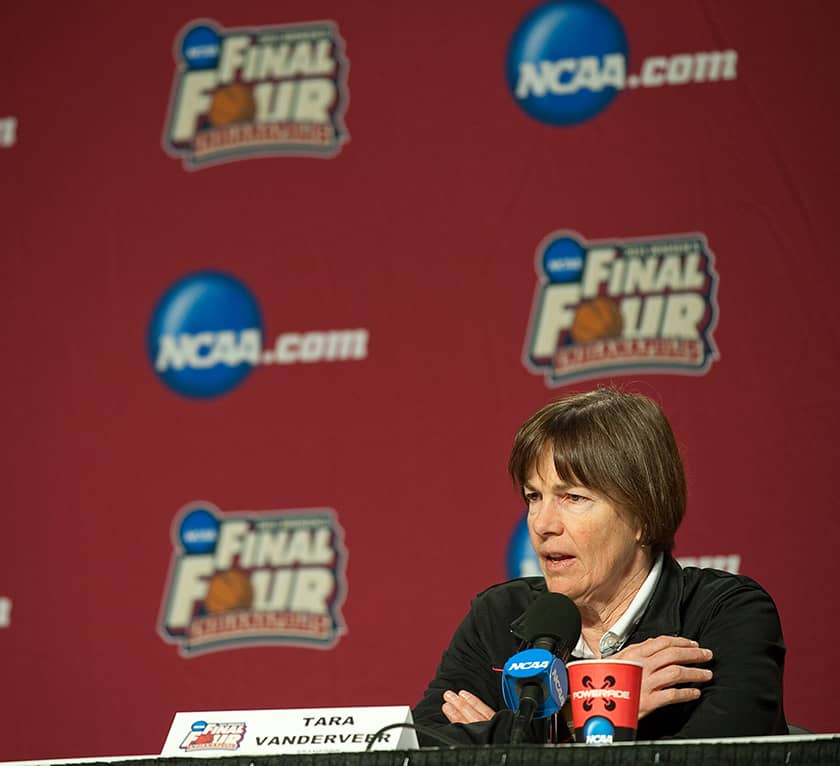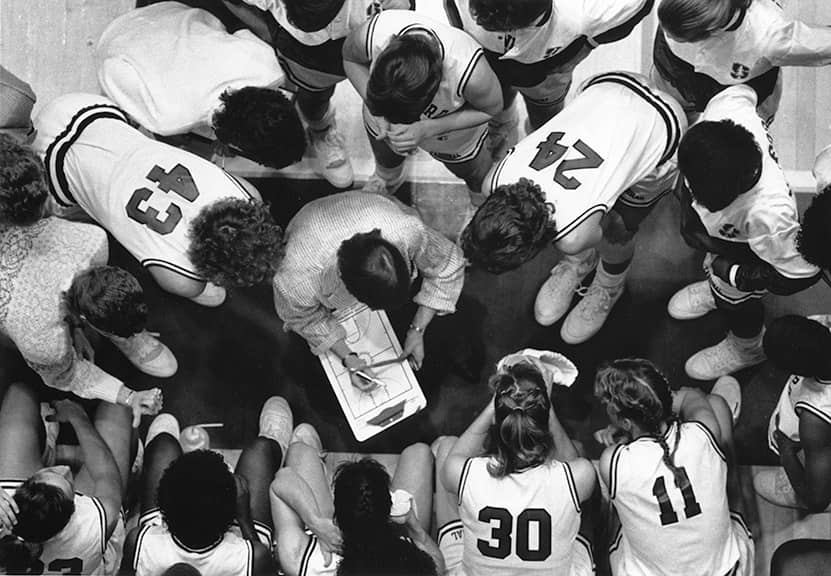The Georgia Dome in Atlanta was massive – the second-largest covered stadium in the world on this day in 1996. Underneath its Teflon-coated fiberglass fabric roof were 171 luxury boxes, and countless rooms and secret places.
On August 4, as a record women’s basketball crowd of 33,952 filtered in for the Olympic gold-medal game, coach Tara VanDerveer looked for a dark, secluded spot before her U.S. team took the floor.
Finding an empty room among the maze of hallways, suites, and broom closets, VanDerveer settled and closed her eyes.
She drifted back to her childhood in upstate New York, and the pull basketball had on her even then. That girl loved basketball at its essence, the strategies and movements and skills. But the game never seemed to reward her.
There were no teams for that girl to play on, no one to offer encouragement for the hours she spent each day shooting and dribbling at her neighbor’s hoop. Her family didn’t have one. Though Tara had an open invitation, she could take a hint when the neighbors parked under the basket.
“My parents thought I was crazy too,” said VanDerveer, in her 38th season as Stanford’s Setsuko Ishiyama Director of Women's Basketball and now the winningest coach in college basketball history. “They’d tell me, ‘Come in and do your algebra homework! Basketball is never going to take you anywhere!’”
VanDerveer can’t pinpoint why she fell in love with the game, but it likely started with the Boston Celtics. Her father loved that team. Though the Knicks were in-state and got most of the play on the weekly games televised in the Schenectady area, it was Celtics guard Bob Cousy that captured her attention. And after the family moved to Niagara Falls in VanDerveer’s sophomore year of high school, it was Niagara University guard Calvin Murphy, the future NBA star, who kept her mesmerized.
She listened to games on the radio, read every book on the sport she could find.
“I don’t know what it was about basketball,” she said. “I’d watch hockey and football too, but basketball was just different. I think the strategy of it was always intriguing to me.”
At first, girls joined the boys at the neighborhood hoop. But as they got older, the girls lost interest and the boys wanted little to do with Tara. She solved this problem by buying the best basketball she could. When they told her to get lost, she had an easy comeback: “Then you can’t use my ball.”
They usually would change their minds.

My parents thought I was crazy too ... They’d tell me, ‘Come in and do your algebra homework! Basketball is never going to take you anywhere!’
VanDerveer didn’t make the cheer team as a freshman at The Milne School in Albany, and instead played rec basketball with “old guys” at a grade school close to her house. Upon the end of the school year, her gym teacher, who also was the boys’ basketball coach, wrote in her yearbook: “To the best basketball player in the ninth grade, boy or girl.”
The quote made her feel “proud,” and remains special – a rare blessing at a time when her interest was being discouraged at every turn.
Through all those hours alone at the neighbor’s hoop, VanDerveer imagined herself in a big arena, in front of a big crowd, shooting the free throw that would win the big game, even though there was no precedent, and no prospect.
“How could I imagine it?” she said recently. “I’d never seen it.”
In Niagara Falls, Dunbar and Rita VanDerveer surprised Tara at Christmas with a basketball hoop of her own, attached to the front of the garage and over the concrete driveway.
Rather than being thrilled, Tara felt betrayed.
“I’m too old for basketball,” she told them. In fact, the gift brought forth the painful feelings of the lack of support and lack of opportunities.
“I was so hurt by it,” she said. “I told them, ‘You said it’s not going to take me anywhere, so don’t bother now.’”
She considered what basketball had gotten her so far … nothing.
“It was painful to love something so much,” she said.
Things began to change at Buffalo Seminary, a private girls school, where there was a limited sports program. VanDerveer played field hockey and basketball, the latter with a schedule of maybe three games in which she wore a gymsuit, not a uniform.
For college, VanDerveer chose Albany State, which had a team. But VanDerveer found herself doing everything – jumping center, and leading in scoring, rebounding, and turnovers. Though an improvement, VanDerveer missed the team experience she was seeking.
Therefore, she convinced four of her friends to load into her car in 1972 for a trip to Normal, Illinois, for the first AIAW national women’s basketball tournament. With a pen and pad, Tara took notes on each team. She watched Indiana play, enjoyed their style and noticed its number of returners and thought, that’s where I want to go. For the first time, she had found like-minded women who shared the same aspirations and frustrations.
VanDerveer made an impact on the court all right, though perhaps not in the way she intended.
“I couldn’t shoot, I was never in shape, I couldn’t guard anybody,” she said. “I turned the ball over a lot.”
What would a scouting report say?
VanDerveer didn’t need much time to think: “Can’t shoot. Don’t guard her. Take it at her.”
After one turnover, coach Bea Gorton, removed her from the game.
“Tara, you need to take care of the ball.”
“I read that John Wooden said that having turnovers meant that you were trying to make things happen,” VanDerveer replied.
“Make a little less happen.”

VanDerveer said she never intended to be a coach. She thought she was headed to law school. But VanDerveer was drawn to the coaching class taught by legendary Bobby Knight. He invited anyone in his class to attend his otherwise closed practices. VanDerveer took him up on that.
“I don’t think he meant every day,” she said. “But I did come every day.”
Sometimes she did homework, but more often she paid attention and took notes.
“That’s one of the reasons I like practice so much,” she said. “I love practice. And he ran a great one.”
She still uses some aspects of Knight’s practices, such as its pace and efficiency, in the way she coaches at Stanford.
VanDerveer’s Indiana teams played an eight-game regular-season schedule and reached the AIAW final four in her sophomore year of 1973 and the quarterfinals in 1974. They played two games a day, paid for their own meals, brought their own shoes, and slept four to a room.
It was paradise. “Beyond anyone’s wildest imagination,” she said.
As she and her teammates spent time together, they talked about the future.
“Some day there will be scholarships for women,” VanDerveer told them. “Someday there will be pro teams …”
“Oh Tara, shut up! You’re crazy!” they said.
VanDerveer, the Olympic coach, considered all this as she sat alone in a darkened Atlanta room, memories flashing in her mind, great ones and painful ones. She thought of a little girl who loved basketball, but had no hope for the future. Yet here she was.
In a few moments, thousands of fans would step through the stadium’s doors. They would cheer her team on. The dreams of little girls throughout the world could now come true.
“This is what you imagined back then,” she realized. “And it’s real.”
It was time. VanDerveer stood slowly, soaked in the moment, and walked toward the court.
She had a game to win.
